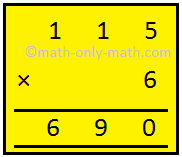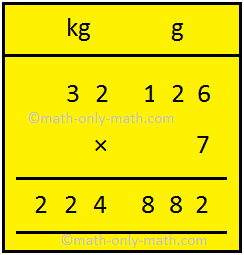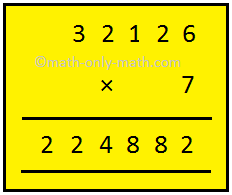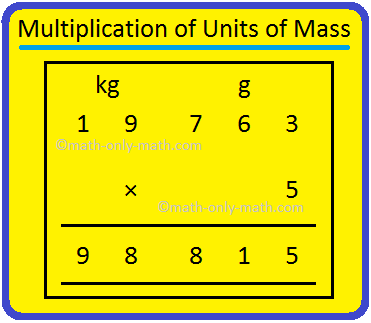Subscribe to our ▶️ YouTube channel 🔴 for the latest videos, updates, and tips.
Multiplication of Units of Mass
We can multiply the units of mass kg and g by a number like ordinary numbers.
1. Multiply 115 kg by 6.
Hence, 115 kg × 6 = 690 kg
2. Multiply 32 kg 126 g by 7.
Multiply the grams by 7.
126 × 7 = 882 g. Write 882 under g column.
Multiply the kilograms
32 × 7 = 224 kg
Write 224 under kg column.
Hence, 32 kg 126 g × 7 = 224 kg 882 g.
When measurements are given as combination of two units, we can also first convert the bigger units to lower units and then multiply.
Alternative method:
First convert 32 kg 162 g into gram and then multiply by 7.
32 kg 126 g = 32000 g + 126 g
= 32126 g
32126 × 7 = 224882 g
Convert 224882 g into kg
224882 g = 224000 + 882 g
= 224 kg + 882 g
= 224 kg 882 g
Hence 32 kg 126 g × 7 = 224 kg 882 g
3. Multiply 19 kg 763 g by 5.
Solution:
First convert 19 kg 763 g into gram and then multiply by 5.
19 kg 763 g = 19000 g + 763 g
= 19763 g
19763 × 5 = 98815 g
Convert 98815 g into kg
98815 g = 98000 + 815 g
= 98 kg + 815 g
= 98 kg 815 g
Hence, 19 kg 763 g × 5 = 98 kg 815 g
Questions and Answers on Multiplication of Units of Mass:
1. The weight of one piece of each object is given. Find the weight of more.
(i) 5 bottles: __________
(ii) 20 pairs of shoes: __________
(iii) 10 books: __________
(iv) 45 bats: __________
(v) 17 chairs: __________
(vi) 16 pairs of skating boots: __________
Answers:
1. (i) 9 kg
(ii) 30 kg
(iii) 31 kg 500 g
(iv) 40 kg 500 g
(v) 72 kg 250 g
(vi) 42 kg 80 g
2. Multiply the given:
(i) 7 kg 34 g by 10
(ii) 42 g 30 mg by 5
(iii) 48 kg 16 g by 6
(iv) 80 kg 450 g by 3
(v) 33 g 72 mg by 11
(vi) 9 kg 355 g by 6
Answers:
2. (i) 70 kg 340 g
(ii) 210 g 150 mg
(iii) 288 kg 96 g
(iv) 241 kg 350 g
(v) 363 g 792 mg
(vi) 56 kg 130 g
5th Grade Numbers
5th Grade Math Problems
From Multiplication of Units of Mass to HOME PAGE
Didn't find what you were looking for? Or want to know more information about Math Only Math. Use this Google Search to find what you need.







New! Comments
Have your say about what you just read! Leave me a comment in the box below. Ask a Question or Answer a Question.